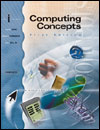COMPUTERS IN YOUR LIFE TOMORROW Do You Have a Crystal Ball? Well, if you do have a crystal ball, we'd certainly like
to borrow it sometime. The simple fact of the matter is that no
one can predict the future with any real consistency, especially
with respect to technology. However, we can make some statements regarding the future of
technology in general. For example, we know that future
technologies will begin to incorporate more of your senses
(speech for example), just as we discussed in Chapter 9. We also
know that complete and high-speed wireless communications are
just around the corner. But how those will come about and exactly
when is a mystery. This Life-Long Learning Module
will take you on a whirlwind tour of what we think the future
holds for technology. More importantly, we want to alert you to
how the future of technology will impact your personal life, the
life of business, and your career. We call these Life-Long Learning Modules
because we want you to visit them long after you've
completed your computer class. The content in this particular
module will change frequently, and perhaps dramatically. Book
mark it (
www.mhhe.com/i-series ) and drop back in for a visit from time to time. BIG TODAY -- HOW SMALL TOMORROW? Technology today is still relatively "big." Although you may
think that a PDA that weighs less than a pound is small,
tomorrow's PDAs will be about the size of a credit card and
weigh about the same amount. Sound too good to be true? Not so
-- technology tomorrow may become so small that you
won't even be aware of its existence. What's even more
important is that those "hard to see" computers will process
billions and billions of instructions in a single second. HERE TODAY -- NOWHERE TOMORROW? We still live in a world of physical boundaries -- homes,
states, and even countries. Of course, technologies such as the
Web have helped eliminate many of those boundaries. But we have a
long way to go. Imagine living in a world where location
doesn't matter, a world in which you can run the
world's largest organization from your garage or in a wheat
field in Kansas. Imagine, too, a world where language limitations
are no longer an issue -- it's coming sooner than you
think. Come with us and explore a "locationless" tomorrow. INTERNET TIME TODAY -- WHEN TOMORROW? Just like physical boundaries, we also operate in a world
constrained by time. But soon time will also become irrelevant.
It's not that we'll operate 24 hours a day --
it's that we'll operate without regard for even the day
of the week, the month of the year, or perhaps even the year. In
the virtual world, there are no physical limitations or
boundaries -- time is one such limitation that will not be
present (past or future) in a virtual world. Come with us and
explore a "timeless" tomorrow. SEE TECHNOLOGY TODAY -- TRANSPARENT TECHNOLOGY
TOMORROW? Transparent technology refers to the fact that technology may
become such an integral and everyday part of our lives that we
won't even acknowledge its existence. Think about
electricity. Every organization needs it to survive, but how many
organizations include electricity in their strategic plan? None,
because electricity is transparent after a fashion. At www.mhhe.com/i-series , let's explore how technology can become transparent in the business world. TECHNOLOGY FOCUS TODAY -- WHAT TOMORROW? Today, technology is such a hot buzzword that everyone seems
to be focusing more on it than the most important issue --
how to use technology for the betterment of people, society, and
the business world. Let's take a glimpse into the future and
see what it looks like when technology becomes transparent from a
societal point of view. | 



 2002 McGraw-Hill Higher Education
2002 McGraw-Hill Higher Education


 2002 McGraw-Hill Higher Education
2002 McGraw-Hill Higher Education